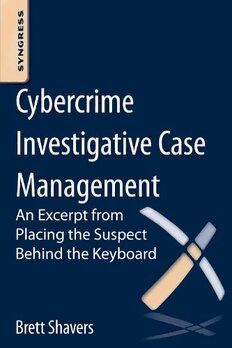
Cybercrime Investigative Case Management: An Excerpt from Placing the Suspect Behind the Keyboard PDF
Preview Cybercrime Investigative Case Management: An Excerpt from Placing the Suspect Behind the Keyboard
Cybercrime Investigative Case Management This pageintentionallyleftblank Cybercrime Investigative Case Management Using Digital Forensics and Investigative Techniques to Identify Cybercrime Suspects Brett Shavers AMSTERDAM(cid:129)BOSTON(cid:129)HEIDELBERG(cid:129)LONDON NEWYORK(cid:129)OXFORD(cid:129)PARIS(cid:129)SANDIEGO SANFRANCISCO(cid:129)SINGAPORE(cid:129)SYDNEY(cid:129)TOKYO SyngressisanimprintofElsevier SyngressisanimprintofElsevier TheBoulevard,LangfordLane,Kidlington,Oxford,OX51GB,UK 225WymanStreet,Waltham,MA02451,USA Firstpublished2013 Copyrightr2013ElsevierInc.Allrightsreserved. ThematerialinthisbookisexcerptedfromPlacingtheSuspectBehindtheKeyboard:Using DigitalForensicsandInvestigativeTechniquestoIdentifyCybercrimeSuspects. Nopartofthispublicationmaybereproducedortransmittedinanyformorbyanymeans, electronicormechanical,includingphotocopying,recording,oranyinformationstorageand retrievalsystem,withoutpermissioninwritingfromthepublisher.Detailsonhowtoseek permission,furtherinformationaboutthePublisher’spermissionspoliciesandourarrangement withorganizationssuchastheCopyrightClearanceCenterandtheCopyrightLicensingAgency, canbefoundatourwebsite:www.elsevier.com/permissions. Thisbookandtheindividualcontributionscontainedinitareprotectedundercopyrightby thePublisher(otherthanasmaybenotedherein). Notices Knowledgeandbestpracticeinthisfieldareconstantlychanging.Asnewresearchand experiencebroadenourunderstanding,changesinresearchmethods,professionalpractices, ormedicaltreatmentmaybecomenecessary. Practitionersandresearchersmustalwaysrelyontheirownexperienceandknowledgein evaluatingandusinganyinformation,methods,compounds,orexperimentsdescribedherein. Inusingsuchinformationormethodstheyshouldbemindfuloftheirownsafetyandthesafety ofothers,includingpartiesforwhomtheyhaveaprofessionalresponsibility. Tothefullestextentofthelaw,neitherthePublishernortheauthors,contributors,oreditors, assumeanyliabilityforanyinjuryand/ordamagetopersonsorpropertyasamatterofproducts liability,negligenceorotherwise,orfromanyuseoroperationofanymethods,products, instructions,orideascontainedinthematerialherein. Trademarks/RegisteredTrademarks:Brandnamesmentionedinthisbookareprotectedbytheir respectivetrademarksandareacknowledged. BritishLibraryCataloguinginPublicationData AcataloguerecordforthisbookisavailablefromtheBritishLibrary LibraryofCongressCataloging-in-PublicationData AcatalogrecordforthisbookisavailablefromtheLibraryofCongress ISBN:978-0-12-409506-9 ForinformationonallSyngresspublications visitourwebsiteatstore.elsevier.com ThisbookhasbeenmanufacturedusingPrintOnDemandtechnology.Eachcopyisproduced toorderandislimitedtoblackink.Theonlineversionofthisbookwillshowcolorfigures whereappropriate. CONTENTS Chapter 1 Investigative Case Management...........................................1 1.1 Introduction..............................................................................1 1.1.1 Basic Case Tracking..................................................................2 1.1.2 The Case Name.........................................................................3 1.1.3 Note Taking..............................................................................5 1.1.4 Analyzing Your Notes...............................................................6 1.1.5 Analysis with Spreadsheets........................................................9 1.1.6 Analysis with Databases..........................................................12 1.1.7 Analysis Using Charts.............................................................15 1.1.8 Analysis Using Maps...............................................................18 1.1.9 Fresh Set of Eyes.....................................................................21 1.1.10 Summary.................................................................................21 Bibliography.......................................................................................22 This page intentionallyleftblank 11 CHAPTER Investigative Case Management 1.1 INTRODUCTION...................................................................................1 1.1.1 Basic Case Tracking.......................................................................2 1.1.2 The Case Name..............................................................................3 1.1.3 Note Taking....................................................................................5 1.1.4 Analyzing Your Notes...................................................................6 1.1.5 Analysis with Spreadsheets.........................................................9 1.1.6 Analysis with Databases............................................................12 1.1.7 Analysis Using Charts................................................................15 1.1.8 Analysis Using Maps..................................................................18 1.1.9 Fresh Set of Eyes........................................................................21 1.1.10 Summary......................................................................................21 BIBLIOGRAPHY.........................................................................................22 1.1 INTRODUCTION This chapter introduces several methods which may allow you to see inferences as you manage the information in your case. These infer- ences help connect the dots between evidence and suspects. Instead of simply taking notes during your investigation, create a system that can lead to discoveries that may be otherwise missed. Gone are the days of writing reports and placing reports in binders such as seen in Figure 1.1. A case with any amount electronic evidence from a single storage device will quickly overwhelm a system of binders. Investigative case management enables you to find information quickly and help you understand your investigation as a whole. Comprehending your reconstruction of the incident in your investiga- tion will allow to you see the totality of the reconstructed incident as if 2 CybercrimeInvestigativeCaseManagement Figure1.1Findingasingledocumentinashelfofbinderscantakemoretimethannecessarycomparedtosearch- inganelectronicfolder. you were there when it occurred. You will have more “Eureka!” moments when data can be seen as a whole and inferences between suspects and acts stand out clearly among all information. There may be a few investigators and analysts who can keep a neat deskduringcomplexcaseswhilsttherestofusstruggletokeepaheadof growing mounds of paper. Hundreds of pages are printed to be sorted throughout the case, duplicates of forms, photos, mail, court orders, and evidence requests are constantly generated to be filed in some man- ner, and this can quickly engulf anyone. With multiple cases and exams of multiple storage devices in each case generating even more case records, a common scene of the work area can appear to look like the resultsofasmallofficehurricane.Workareasthatareclutteredanddis- organized will also coincidently consist of cases that are not solved quickly, or even solved at all. This chapter intends to give methods of controllinginformationandanalyzingitatthesametime. 1.1.1 Basic Case Tracking If there is one rule to remember, it is to handle evidence and informa- tion as it is collected. As long as each item is bagged and tagged in your system, the odds of losing or overlooking information are mini- mized. Bagging and tagging can easily be accomplished using logs where evidence or information that arrives is logged on paper, as it arrives, and filed away. InvestigativeCaseManagement 3 Tip A Stitch in Time Saves Nine I have never seen success with any method of evidence that does not involve handling it immediately when collected. Evidence that is placed asidetodealwithatalatertimeusuallyresultsinlostormissingevidence or forgetting where items of evidence originated. Handle it as soon as you touch it or you may never see it again. All other methods of dealing with evidence make your case man- agement that much easier. If you have a good system already, perhaps it can be made better using one of the methods described. And if one suggestion saves you minutes or hours over a period of time, then it is a worthwhile change to make. Although electronic data can be reproduced and fingerprint cards photocopied and scanned, the reproductions of the actual physical items cannot be cloned. The storage of these types of items requires safe storage within a secured facility. Physical evidence storage is vitally important, but this will not be the focus of this chapter. The focus is to manage your investigation information so that suspects can be clearly identified and evidence supporting suppositions are evident. 1.1.2 The Case Name Before you can analyze your own information, you need to be able to find it. As seemingly unimportant it sounds, naming your cases deserves some attention. Depending upon your agency or organization, there may be an automated system for case names and you have no choice other than what the system gives you. There is nothing wrong with that as an internal system is already in place. But what if you are responsible for creating the name for all your cases? In that instance, especially if there is more than one person that works cases in your organization, having any system is better than having more than one system or no system at all. Figure 1.2 shows a simple case numbering system that is based on the date the case was created with an additional sequential number if more than one case is drawn on that particular day.
